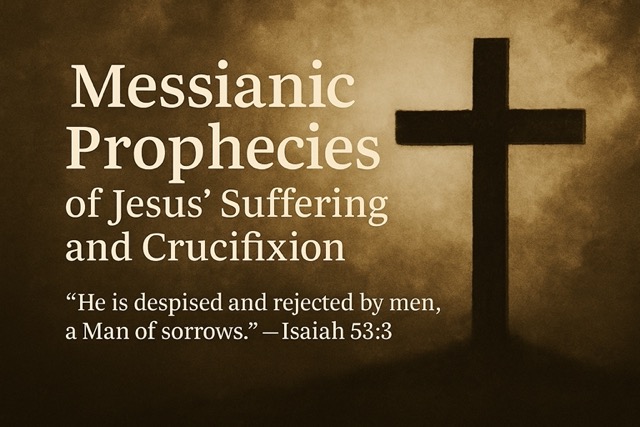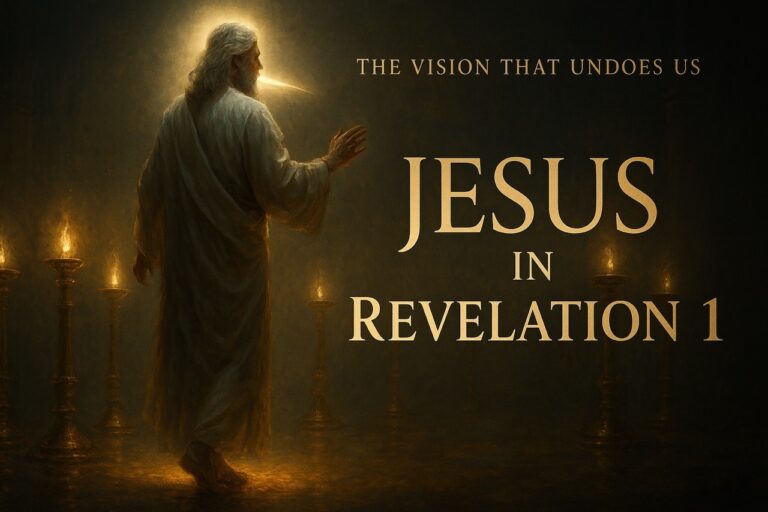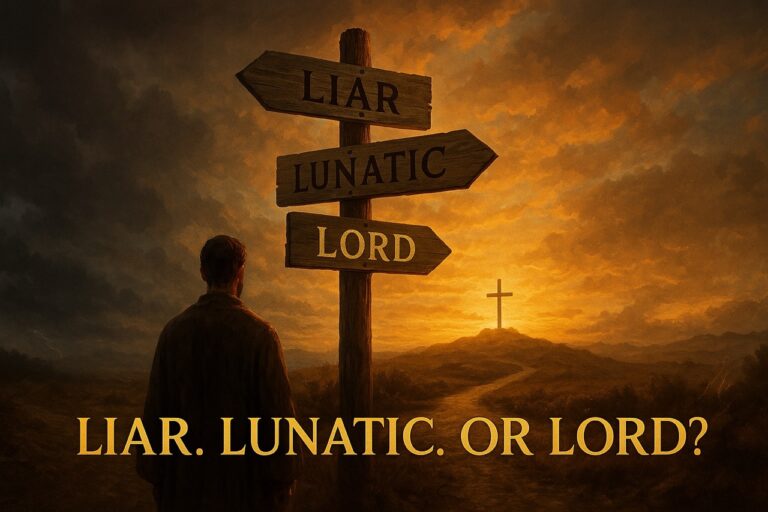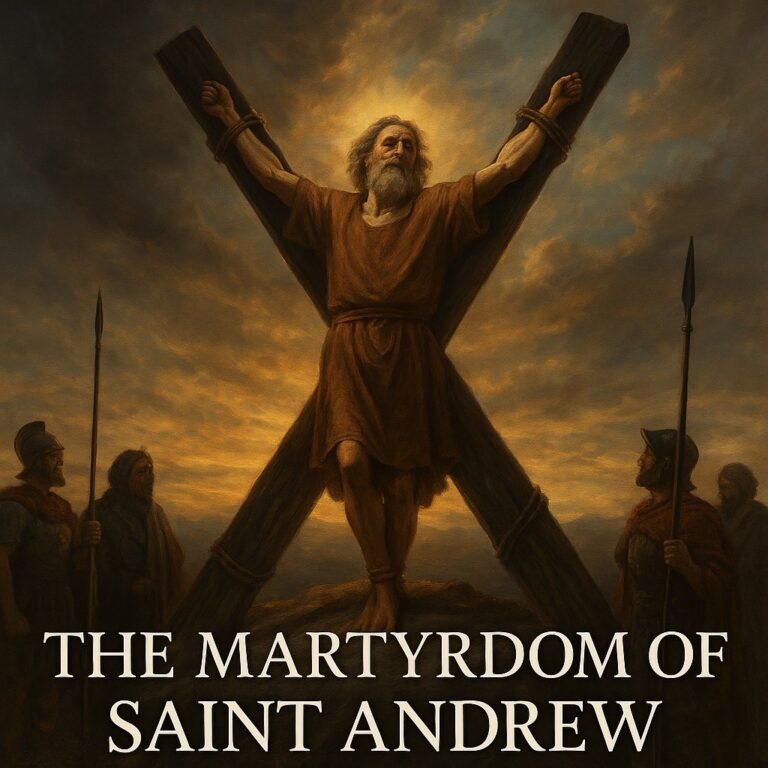The Old Testament contains some of the most vivid and detailed Jesus’ crucifixion prophecies — written centuries before the cross. These ancient scriptures don’t speak in generalities. They describe, with sacred precision, a suffering Messiah: pierced hands, mocking crowds, lots cast for His garments, and burial among the rich — long before Roman crucifixion was even invented.
“He was pierced for our transgressions…” — Isaiah 53:5
This wasn’t coincidence.
It was choreography.
Jesus’ death was not a tragic accident. It was God’s plan from the beginning — a divine promise spoken through prophecy and fulfilled down to the final breath.
In this in-depth guide, we’ll explore every major messianic prophecy that pointed directly to Jesus’ crucifixion, examining how each one was fulfilled in the Gospels. Along the way, we’ll uncover Hebrew word studies, theological insights, and Gospel connections that prove He truly is the Promised One.
💀 They didn’t die for a lie.
See how all of Jesus’s disciples died — and what it proves.
Want the full breakdown of fulfilled messianic prophecy?
View our master guide: 351 Prophecies Jesus Fulfilled in Scripture →
✝️ Want to go EVEN deeper?
Explore the historical evidence of Jesus through ancient writings, Roman records, and archaeological discoveries that confirm His life and crucifixion. 🔍 Read the full article →
📜 Prophetic Preview: What This Study Covers
Before we dive into the detailed verse breakdowns, here’s a preview of the key prophecies explored in this article — all fulfilled by Jesus on the cross:
| 🔍 Prophecy | 📖 Old Testament | ✝️ Fulfillment |
|---|---|---|
| The Suffering Servant | Isaiah 53:3–10 | Matthew 8:17, 1 Peter 2:24 |
| Pierced hands and feet | Psalm 22:16–18 | John 20:25–27 |
| Looked upon by those who pierced Him | Zechariah 12:10 | John 19:37, Revelation 1:7 |
| Given gall and vinegar | Psalm 69:21 | Matthew 27:34, John 19:28 |
| Not one bone broken | Psalm 34:20 | John 19:33–36 |
| The Anointed One cut off | Daniel 9:26 | Luke 24:25–27, Acts 8:32–35 |
Each prophecy is not only quoted but deeply fulfilled — word for word, moment by moment — in the suffering and crucifixion of Jesus Christ.
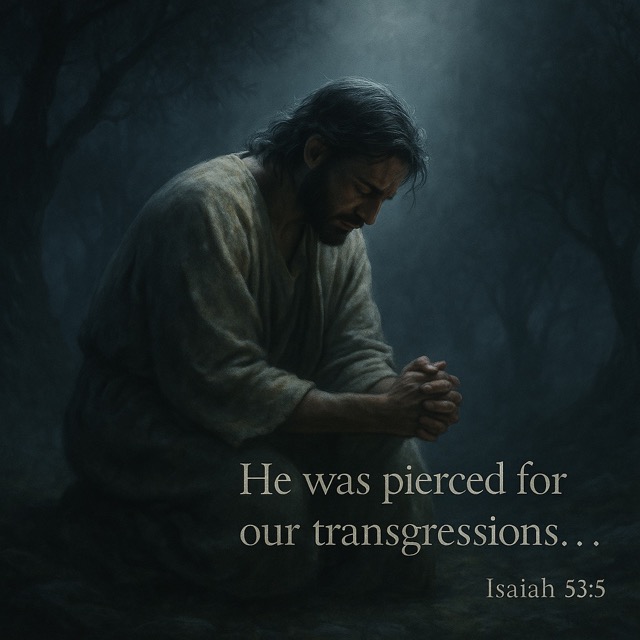
✝️ Prophecy Spotlight: Isaiah 53 — The Suffering Servant
“He was pierced for our transgressions,
crushed for our iniquities…
and the Lord has laid on Him the iniquity of us all.”
— Isaiah 53:5–6
🔍 Old Testament Insight
Isaiah 53 is the crown jewel of messianic prophecy on suffering. Written over 700 years before the crucifixion, it describes in stunning detail the rejection, sorrow, substitution, and sacrificial death of the coming Messiah.
It’s not symbolic. It’s surgical.
Here are the key prophetic elements:
- Despised and Rejected (v3) — the Messiah would be dismissed by His own people
- Pierced and Crushed (v5) — a prophecy of violent suffering for others’ sins
- Silent Like a Lamb (v7) — He would go willingly, like a sacrificial lamb
- Buried With the Rich (v9) — fulfilled when Jesus was laid in a wealthy man’s tomb
- “He shall bear their iniquities” (v11) — substitutionary atonement, foretold in advance
Even the tense and pronouns shift between singular (“He”) and plural (“we”), showing the Servant suffers on behalf of others.
🧠 Theological Commentary
R.C. Sproul called Isaiah 53 “the clearest prophecy of penal substitution in the Old Testament.”
John MacArthur said: “This passage is so vivid, some have called Isaiah the fifth Gospel.”
💬 Early Jewish writings — like Targum Jonathan and certain Dead Sea Scrolls — interpreted Isaiah 53 as messianic long before it was downplayed in modern Judaism.
The chapter’s imagery mirrors the Levitical sacrifices: the innocent bearing guilt, the lamb being led to slaughter, and the offering made on behalf of others.
✝️ New Testament Fulfillment
Isaiah 53 is referenced or alluded to more than 20 times in the New Testament — woven into the Gospel accounts, the Epistles, and Acts:
- Matthew 8:17 — “He took our infirmities and bore our diseases”
- John 12:38 — “Lord, who has believed our report?”
- Acts 8:32–35 — Philip uses Isaiah 53 to explain Jesus to the Ethiopian eunuch
- Romans 4:25 — “Delivered over for our sins”
- 1 Peter 2:24 — “He bore our sins in His body on the tree”
- Hebrews 9:28 — “Christ was offered once to bear the sins of many”
From His silence before Pilate to the exact phrasing of His death, Jesus fulfills Isaiah 53 in precise detail.

✝️ Jesus’ Crucifixion Prophecies in Psalm 22
“They pierced My hands and My feet…
They divide My garments among them,
and for My clothing they cast lots.”
— Psalm 22:16, 18
🔍 Old Testament Insight
Psalm 22 was written by King David around 1000 BC. Though describing deep personal agony, it prophetically foreshadows the exact events of Jesus’ crucifixion — centuries before crucifixion was even invented.
It opens with the cry Jesus would later voice on the cross:
“My God, My God, why have You forsaken Me?” — Psalm 22:1
Key messianic details include:
- Mockery by Onlookers (vv6–8): “He trusts in the LORD; let Him rescue Him!”
- Pierced Hands and Feet (v16): “They pierced My hands and feet”
- Disjointed Bones and Thirst (vv14–15): “My strength is dried up… My tongue sticks to My jaws”
- Gambling for Garments (v18): “They cast lots for My clothing”
✨ David never experienced this form of death — but Jesus did. Every image aligns with Golgotha.
🧠 Theological Commentary
Psalm 22 reads less like a song… and more like a first-person account of crucifixion.
Derek Kidner notes:
“No incident recorded of David fits this psalm… its fulfillment is found only at Calvary.”
John Piper calls it:
“A pre-crucifixion narrative — before crucifixion even existed.”
The Hebrew word כָּאֲרִי (karah) in verse 16 literally means “to dig through” — a word used for piercing flesh. And the detail of divided garments is so specific, it’s quoted directly in all four Gospels.
✝️ New Testament Fulfillment
Psalm 22 is one of the most visibly and literally fulfilled passages in all of Scripture:
- Matthew 27:46 — Jesus cries: “My God, My God, why have You forsaken Me?”
- Matthew 27:35 / John 19:24 — Soldiers cast lots for His clothing
- Luke 23:35–36 — He is mocked using language echoing Psalm 22:8
- John 19:28 — Jesus says “I thirst,” echoing Psalm 22:15
- John 20:25–27 — Thomas confirms the piercing of His hands
From emotional abandonment to exact physical torment, Jesus fulfills Psalm 22 line by line — as if the psalm was written while standing at the foot of the cross.
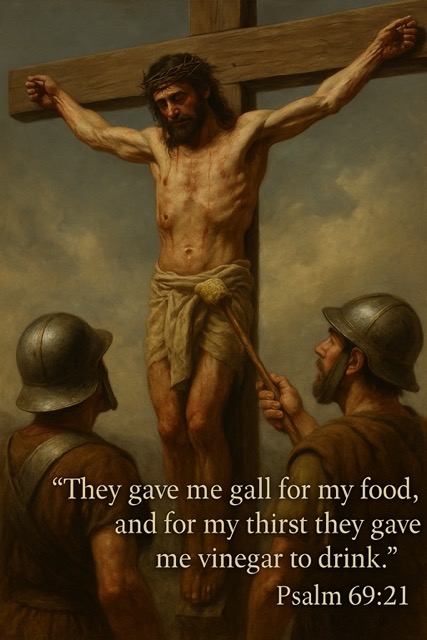
✝️ Prophecy Spotlight: Psalm 69 — Gall, Vinegar, and Zeal for the Temple
“They gave Me gall for My food,
and for My thirst they gave Me vinegar to drink.”
— Psalm 69:21
🔍 Old Testament Insight
Psalm 69 is a cry of anguish — written by David but saturated with prophetic glimpses of the Messiah’s suffering. The psalm blends emotional betrayal with physical torment and rejection by one’s own people.
While David speaks from personal affliction, the imagery reaches beyond him:
- Psalm 69:4 — “They hated Me without cause”
- Psalm 69:7–9 — “Zeal for Your house has consumed Me”
- Psalm 69:20 — “I looked for comforters, but found none”
- Psalm 69:21 — Bitter mockery: gall and vinegar instead of comfort
These details are more than metaphor — they foreshadow Calvary with chilling specificity.
🧠 Theological Commentary
Psalm 69 is one of the most frequently quoted psalms in the New Testament, especially in connection with Jesus’ rejection and suffering.
Charles Spurgeon wrote:
“This psalm has more of Christ in it than almost any other.”
John MacArthur adds:
“The world gave Jesus its worst — bitterness when He thirsted, cruelty when He suffered.”
The offering of gall and vinegar is a prophetic image of mockery, not mercy — denying Jesus even the most basic human comfort during His agony.
Psalm 69 also ties Jesus’ zeal for God’s house to His righteous anger in cleansing the Temple.
✝️ New Testament Fulfillment
Every major element of Psalm 69 finds its fulfillment in Jesus’ final hours:
- Matthew 27:34 — “They gave Him wine mingled with gall to drink”
- John 19:28–30 — “I thirst”… followed by sour wine on a hyssop branch
- John 2:17 — “Zeal for Your house has consumed Me” is quoted after Jesus clears the Temple
- John 15:25 — “They hated Me without cause” is cited as fulfilled in the rejection of Christ
Psalm 69 reveals not just the pain Jesus endured — but the cold-hearted cruelty of the crowd… and the precision with which He fulfilled prophecy.
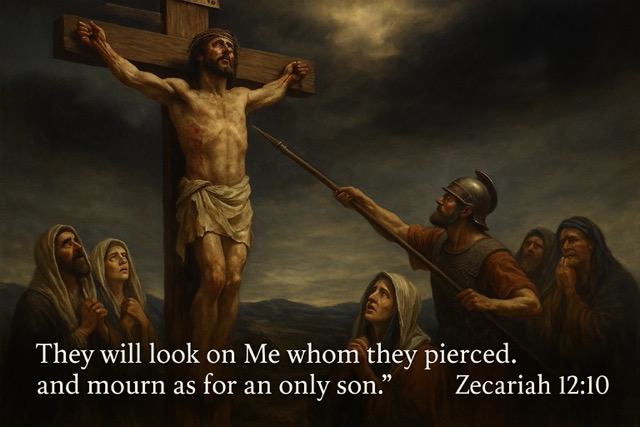
✝️ Prophecy Spotlight: Zechariah 12:10 — “They Will Look on Me Whom They Pierced”
“They will look on Me whom they have pierced,
and they shall mourn for Him as one mourns for an only child…”
— Zechariah 12:10
🔍 Old Testament Insight
This verse is one of the most profound messianic prophecies — a fusion of divine identity, suffering, and repentance in a single statement.
God speaks directly:
“They will look on Me… whom they have pierced.”
Then shifts:
“They shall mourn for Him.”
This mysterious duality foreshadows Jesus as both divine and pierced — God in human flesh, crucified by those He came to save.
The Hebrew word דָּקַר (dākar) means “to pierce through” — not symbolically, but with a weapon. It is used for execution or deadly violence, not poetic lament.
🧠 Theological Commentary
This verse points prophetically to both the crucifixion and a future moment of recognition.
John MacArthur explains:
“This is a declaration from God that He Himself will be pierced — a mystery only resolved in the person of Jesus Christ.”
R.C. Sproul writes:
“A divine self-reference to the Messiah’s suffering — fulfilled in Christ, and still unfolding in redemptive history.”
The second half of Zechariah 12:10 — the mourning — is often connected with national repentance, aligning with Romans 11:26: “All Israel will be saved.”
This verse bridges the first and second comings of Jesus — pierced in the past, but seen and mourned over in the future.
✝️ New Testament Fulfillment
Zechariah 12:10 is explicitly quoted twice — once at the crucifixion and once in reference to Jesus’ Second Coming:
- John 19:34–37 — After the soldier thrusts a spear into Jesus’ side, John writes: “They shall look on Him whom they pierced.”
- Revelation 1:7 — “Behold, He is coming with the clouds, and every eye will see Him — even those who pierced Him.”
This prophecy is multi-layered:
- Historically fulfilled at the cross
- Theologically fulfilled in recognizing Christ as pierced Messiah
- Eschatologically fulfilled when all the world sees the risen King
Zechariah saw it all — and Jesus fulfilled it, pierced by men, mourned by nations, and ultimately revealed as Lord.
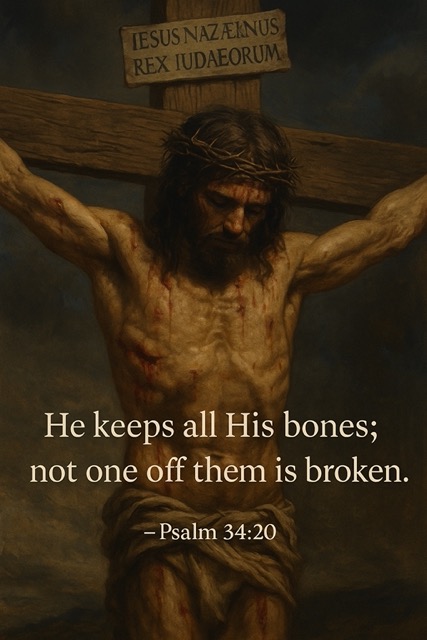
✝️ Prophecy Spotlight: Psalm 34:20 — “Not One of His Bones Will Be Broken”
“He keeps all His bones;
not one of them is broken.”
— Psalm 34:20
🔍 Old Testament Insight
At first glance, this verse from Psalm 34 reads like a general promise of divine protection. But under the Holy Spirit’s inspiration, it becomes a surgical prophecy — fulfilled at the cross, in one of the most overlooked details of Jesus’ death.
In Roman crucifixion, the legs of the dying were often broken to speed death. But when they came to Jesus…
✨ He was already dead.
His bones remained untouched.
Just as the Scripture said.
This prophecy also echoes Exodus 12:46, where the Passover lamb was to have no broken bones — tying Jesus’ death directly to the imagery of the final sacrifice.
🧠 Theological Commentary
John MacArthur explains:
“This was not by chance. The bones of the true Passover Lamb were not to be broken.”
R.C. Sproul adds:
“Psalm 34:20 and Exodus 12:46 converge in one perfect detail at the cross.”
What seemed like a minor detail — His unbroken bones — becomes sacred confirmation:
Jesus is the spotless Lamb, prepared before the foundation of the world.
✝️ New Testament Fulfillment
The Gospels record this moment with care:
- John 19:31–36 — Soldiers break the legs of the thieves… but not Jesus.
“These things happened so that the Scripture would be fulfilled: ‘Not one of His bones will be broken.’” - Exodus 12:46 / Numbers 9:12 — Laws about the Passover lamb forbid bone-breaking.
Jesus is our Passover Lamb (1 Corinthians 5:7), sacrificed without flaw.
Even in death — especially in death — Jesus fulfills prophecy down to the smallest, most hidden detail.
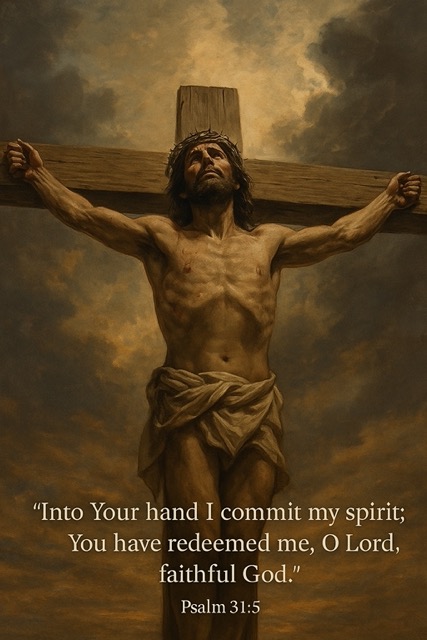
✝️ Prophecy Spotlight: Psalm 31:5 — “Into Your Hands I Commit My Spirit”
“Into Your hand I commit my spirit;
You have redeemed me, O Lord, faithful God.”
— Psalm 31:5
🔍 Old Testament Insight
Psalm 31 is a prayer of trust from a righteous sufferer. David cries out in distress — yet entrusts his life to God, even in the face of death.
When Jesus quoted this verse on the cross, He didn’t just echo David’s cry…
He fulfilled it — showing us that His death was not taken, but freely given.
This wasn’t resignation.
It was victory.
The Son of God chose the moment — and the words — of His final breath.
🧠 Theological Commentary
John Piper says:
“Jesus was not taken. He gave Himself. And this psalm captures that willing surrender.”
Spurgeon calls this verse:
“David’s trust — but Christ’s triumph.”
And John Calvin writes:
“Jesus took up David’s prayer — but with full knowledge of what His death would accomplish.”
The Hebrew word for “redeemed” in this verse is פָּדָה (padah) — a word used for rescuing by ransom. Even in His final moment, Jesus points to redemption — for Himself… and for us.
✝️ New Testament Fulfillment
- Luke 23:46 — “Then Jesus, calling out with a loud voice, said, ‘Father, into Your hands I commit My spirit!’ And having said this, He breathed His last.”
- John 10:17–18 — Jesus says:
“No one takes [My life] from Me… I lay it down of My own accord.”
This was not a gasp of despair…
It was a declaration of sovereignty, trust, and completed mission.
The King died quoting Scripture — fulfilling prophecy with His very last breath.

✝️ Prophecy Spotlight: Daniel 9:26 — “The Anointed One Will Be Cut Off”
“After the sixty-two weeks, the Anointed One shall be cut off and shall have nothing…”
— Daniel 9:26
🔍 Old Testament Insight
Daniel’s Seventy Weeks prophecy is one of the most chronologically specific messianic predictions in the Bible.
Here, the prophet declares that the “Anointed One” (Messiah) will be:
- “Cut off” — a phrase often meaning violent death or judicial execution
- “And shall have nothing” — suggesting loss, rejection, or apparent failure
This points to a Messiah who would die suddenly, be denied earthly inheritance, and appear to be defeated — just as Jesus did on the cross.
Even more astonishing?
Daniel says this happens before the destruction of Jerusalem — which occurred in 70 AD. Jesus’ crucifixion took place around 30–33 AD… perfectly on schedule.
🧠 Theological Commentary
John Walvoord wrote:
“This verse clearly predicts the death of the Messiah — not for Himself, but for others.”
Gleason Archer adds:
“The timeline fits only one person: Jesus of Nazareth.”
The Hebrew phrase יִכָּרֵת (yikkāret) means “to be cut off” — used for a violent, sacrificial death. Jesus wasn’t just a martyr — He was the fulfillment of this prophetic sentence.
This passage connects the timeline of redemption to the Person of Christ with breathtaking accuracy.
✝️ New Testament Fulfillment
- Luke 24:25–27 — Jesus, walking with the disciples on the road to Emmaus, says:
“Was it not necessary that the Christ should suffer these things…?” - Acts 8:32–35 — Philip explains Isaiah 53 and likely Daniel 9 to the Ethiopian eunuch, showing how the Messiah was “cut off” for the sins of many.
- Hebrews 9:26 — “He has appeared once for all… to put away sin by the sacrifice of Himself.”
Jesus was cut off — not for His own sin, but for ours.
He had nothing — so we could receive everything.
And He fulfilled Daniel’s prophetic clock with flawless precision.
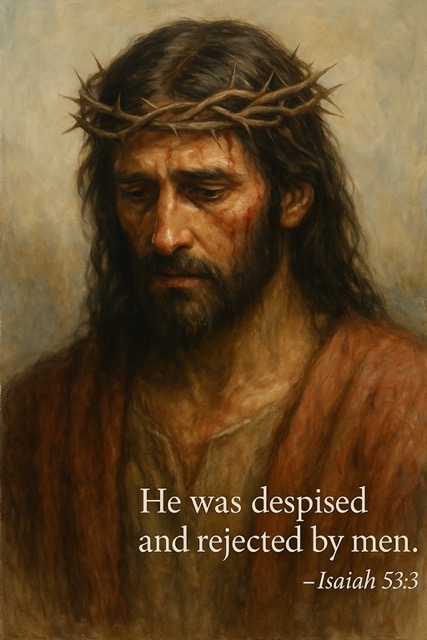
✝️ Prophecy Spotlight: Isaiah 53:1–3 — “He Was Despised and Rejected”
“He was despised and rejected by men,
a Man of sorrows, acquainted with grief…
and we hid our faces from Him.”
— Isaiah 53:3
🔍 Old Testament Insight
Isaiah opens his most profound prophecy not with triumph — but with tragedy.
The Servant of the Lord — the promised Messiah — is not received in glory… but in grief.
He is ignored, misunderstood, and cast aside by those He came to save.
He didn’t look the part.
He didn’t act like a conqueror.
He came lowly… and they turned away.
Isaiah paints a portrait of the Messiah as deeply human, deeply sorrowful, and yet… divinely appointed for redemptive suffering.
🧠 Theological Commentary
John MacArthur calls this “a prophecy of divine irony — the King of Glory, rejected by the very ones He came to redeem.”
R.C. Sproul writes:
“The Servant’s rejection wasn’t random. It fulfilled God’s plan to save us through shame and sorrow.”
Even the opening question in Isaiah 53:1 — “Who has believed our report?” — points to the unbelief that would mark Jesus’ earthly ministry.
The Gospel of John cites this very line to explain why many still would not believe in Him.
✝️ New Testament Fulfillment
- John 1:11 — “He came to His own, and His own did not receive Him.”
- Luke 23:18 — The crowd shouts for Barabbas, choosing a criminal over Christ
- John 12:37–38 — “Though He had done so many signs before them, they still did not believe in Him… that the word of Isaiah might be fulfilled.”
Jesus didn’t just experience rejection — He fulfilled it.
The world turned its face from Him… and He turned His face toward the cross.
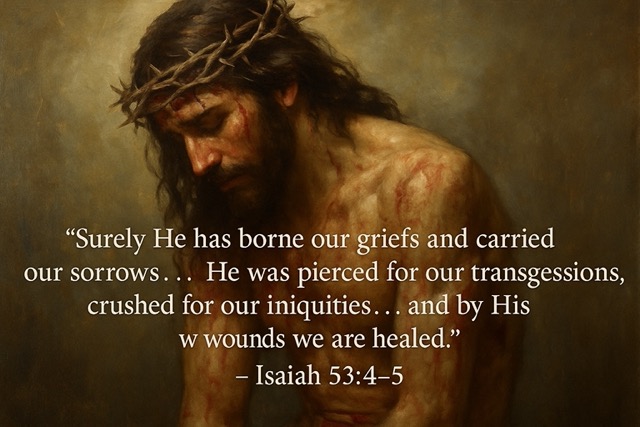
✝️ Prophecy Spotlight: Isaiah 53:4–6 — “He Bore Our Sins”
“Surely He has borne our griefs and carried our sorrows…
He was pierced for our transgressions,
crushed for our iniquities…
and by His wounds we are healed.”
— Isaiah 53:4–5
🔍 Old Testament Insight
These verses are the heart of Isaiah 53 — and of the Gospel itself.
The Servant doesn’t suffer by accident.
He suffers on purpose… and in place of others.
Every phrase speaks to substitution:
- “He bore our griefs…” — carried our pain, both physical and emotional
- “Pierced for our transgressions…” — wounded not for Himself, but for our rebellion
- “Crushed for our iniquities…” — divine judgment placed squarely on His shoulders
- “By His wounds we are healed…” — the great reversal: His pain becomes our peace
Verse 6 sums up humanity:
“All we like sheep have gone astray… and the Lord has laid on Him the iniquity of us all.”
🧠 Theological Commentary
John Stott called Isaiah 53:4–6
“The most comprehensive statement of penal substitution in Scripture.”
D.A. Carson wrote:
“The Servant dies not for His sins — but for ours. This is the Gospel according to Isaiah.”
The Hebrew words here are rich with legal and sacrificial weight:
- פֶּשַׁע (pesha) — “transgression,” meaning willful rebellion
- נָשָׂא (nasa) — “to bear,” meaning to lift and carry away a burden
Isaiah shows that this is not just suffering — it is atonement.
The Servant absorbs wrath… to grant peace.
✝️ New Testament Fulfillment
- Matthew 8:17 — “He took our infirmities and bore our diseases” — quoted directly from Isaiah 53
- 1 Peter 2:24 — “He bore our sins in His body on the tree… by His wounds you have been healed.”
- Romans 4:25 — “He was delivered over to death for our sins and raised for our justification.”
Jesus didn’t just fulfill the prophecy —
He embodied it.
He bore your sin… to give you healing.
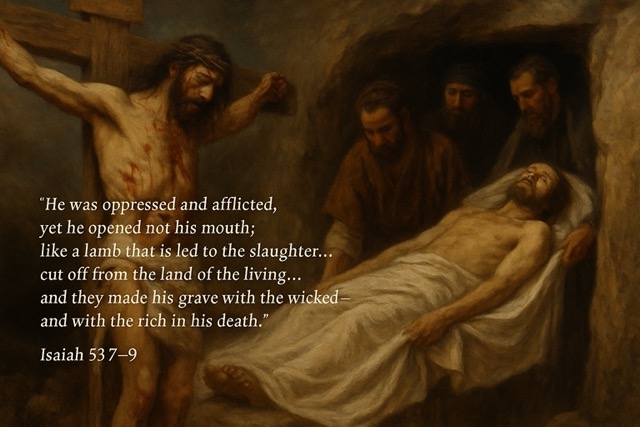
✝️ Prophecy Spotlight: Isaiah 53:7–9 — “Like a Lamb to the Slaughter”
“He was oppressed and afflicted,
yet He opened not His mouth;
like a lamb that is led to the slaughter…
cut off from the land of the living…
and they made His grave with the wicked —
and with the rich in His death.”
— Isaiah 53:7–9
🔍 Old Testament Insight
These verses portray the quiet submission of the Messiah.
- He is wrongfully accused.
- He is silent under oppression.
- He is executed like a criminal… but buried like a nobleman.
Each phrase is a direct prophecy about the final hours of Jesus’ earthly life:
- “Opened not His mouth” — Jesus gave no defense at trial
- “Cut off from the land of the living” — a sudden, violent death
- “Grave with the wicked… and with the rich” — crucified among thieves, buried in a rich man’s tomb
No other figure in history fulfills this paradox so precisely.
🧠 Theological Commentary
Philip Ryken writes:
“Only Jesus matches this description — silent before Pilate, crucified between criminals, buried in a rich man’s tomb.”
John Piper adds:
“Isaiah foresaw not only Jesus’ manner of death — but even the detail of His burial.”
This is not vague poetry — it is surgical prophecy.
It identifies not just what would happen… but how, where, and with whom.
✝️ New Testament Fulfillment
- Matthew 27:12–14 — Jesus stands before Pilate, “but He gave him no answer, not even to a single charge.”
- Luke 23:32–33 — Jesus is crucified “between two criminals.”
- John 19:38–42 — Jesus is buried by Joseph of Arimathea, a wealthy man, in his own new tomb.
- Acts 8:32–35 — The Ethiopian eunuch reads this passage aloud, and Philip declares:
“This is about Jesus.”
Jesus fulfilled this prophecy willingly, silently, and with sacred precision.
The Lamb was slain — exactly as foretold.
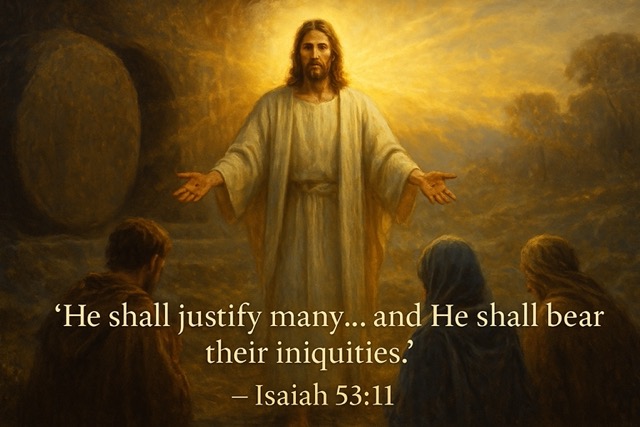
✝️ Prophecy Spotlight: Isaiah 53:10–12 — “He Shall Justify Many”
“Yet it was the will of the LORD to crush Him…
He shall see His offspring; He shall prolong His days…
By His knowledge shall the righteous Servant justify many…
and He shall bear their iniquities.”
— Isaiah 53:10–11
🔍 Old Testament Insight
The prophecy doesn’t end in death.
It ends in resurrection.
It ends in justification.
It ends in glory.
Though the Servant is “crushed” by God’s will, the next lines hint at life after death:
- “He shall prolong His days” — resurrection
- “He shall see His offspring” — spiritual family
- “He shall justify many” — declared righteous by His sacrifice
The final verse adds a royal reward:
“I will divide Him a portion with the great… because He poured out His soul unto death.” — Isaiah 53:12
The Servant dies like a lamb, but rises like a king.
🧠 Theological Commentary
R.C. Sproul said:
“Isaiah doesn’t end in death. He ends in triumph — resurrection and reward.”
Tim Keller wrote:
“This is not just suffering… this is substitution.
The Servant justifies many because He bore their sin.”
This is the Gospel according to Isaiah — not only the suffering of Jesus, but His vindication, resurrection, and saving power.
The Hebrew word for “justify” (צָדַק / tsadaq) means to declare someone righteous — a legal verdict.
And here it’s based not on works, but on His sacrifice.
✝️ New Testament Fulfillment
- Romans 5:18–19 — “By one man’s obedience many will be made righteous.”
- Hebrews 9:28 — “Christ was offered once to bear the sins of many.”
- Acts 2:31–33 — Peter preaches that Jesus was not abandoned to the grave, but raised and exalted.
- Philippians 2:8–11 — “He humbled Himself to death… therefore God has highly exalted Him.”
Isaiah’s Servant becomes the risen Savior.
He is crucified and crowned, rejected and rewarded, wounded and worshiped.
He poured out His soul unto death…
so that you could be declared righteous before God.

✝️ Prophecy Spotlight: Psalm 22:1–8 — “My God, My God, Why Have You Forsaken Me?”
“My God, My God, why have You forsaken Me?”
— Psalm 22:1
🔍 Old Testament Insight
Psalm 22 begins with one of the most haunting cries in all of Scripture — and Jesus would shout it from the cross.
Though written by David, these verses go far beyond his personal experience. They describe the emotional and social agony of a righteous man publicly scorned and spiritually abandoned.
Key prophetic lines:
- Verse 1 — “Why have You forsaken Me?”
- Verse 6–8 — “All who see Me mock Me… ‘He trusts in the Lord; let Him deliver Him!’”
David may have felt forsaken.
But Jesus lived this psalm — out loud and in public view.
🧠 Theological Commentary
Charles Spurgeon called Psalm 22:
“The photograph of our Lord’s saddest hours.”
John Calvin wrote:
“David penned these words in deep anguish… but they reach their fullest meaning in Christ crucified.”
This is not just poetic lament — it’s a spiritual transaction.
Jesus quotes this line to signal that He is entering the full weight of divine judgment, bearing sin, wrath, and abandonment in our place.
God turned His face from Jesus…
so He would never have to turn it from us.
✝️ New Testament Fulfillment
- Matthew 27:46 — “Jesus cried out… ‘My God, My God, why have You forsaken Me?’”
- Mark 15:34 — Repeats the same cry in Aramaic: “Eloi, Eloi, lama sabachthani?”
- Matthew 27:41–43 — The mockers say: “He trusts in God; let God deliver Him” — quoting Psalm 22:8 word for word.
Jesus didn’t just cite Scripture —
He fulfilled it with His whole being, entering its pain, rejection, and loneliness.
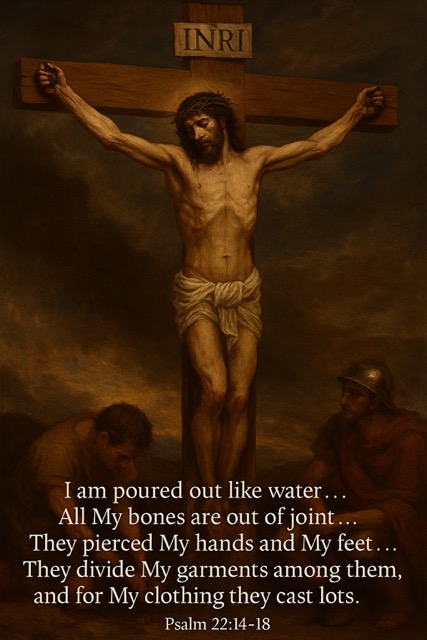
✝️ Prophecy Spotlight: Psalm 22:14–18 — “They Pierced My Hands and Feet”
“I am poured out like water…
All My bones are out of joint…
They pierced My hands and My feet…
They divide My garments among them,
and for My clothing they cast lots.”
— Psalm 22:14–18
🔍 Old Testament Insight
This section of Psalm 22 moves from emotional agony to vivid physical torment — describing in detail a form of death unknown to David, but tragically familiar to us: crucifixion.
Key prophetic details:
- Dislocated bones (v14) — arms stretched and joints pulled out
- Extreme dehydration (v15) — a known effect of crucifixion
- Pierced hands and feet (v16) — literal execution wounds
- Exposed bones (v17) — severe trauma and weight loss
- Divided garments and casting lots (v18) — fulfilled by Roman soldiers
This prophecy describes a public execution with eerie accuracy…
centuries before crucifixion was ever practiced by Rome.
🧠 Theological Commentary
Tim Keller writes:
“Psalm 22 reads like a first-person account of the crucifixion — written centuries in advance.”
Craig Evans, New Testament scholar, affirms:
“The phrase ‘pierced My hands and feet’ is best understood as an execution wound — fulfilled in Roman crucifixion.”
Even skeptics have acknowledged the prophetic detail here is too exact to ignore.
The Hebrew word כָּאֲרִי (karah) — often translated “pierced” — literally means “to dig through” or “bore through.”That’s not metaphor.
That’s a nail.
✝️ New Testament Fulfillment
- John 19:23–24 — Roman soldiers divide Jesus’ garments and cast lots for His tunic
- Luke 24:39–40 — The risen Jesus shows His disciples His hands and feet — visible wounds from the cross
- John 20:25–27 — Thomas demands to see the nail marks in Jesus’ hands — and Jesus shows him
This psalm is not symbolic.
It is the crucifixion before crucifixion — and Jesus lived it, line by line.
🧠 Hebrew Words That Reveal the Depth of Jesus’ Crucifixion Prophecies
Understanding the original Hebrew behind these Old Testament prophecies unlocks deeper meaning and reveals how surgical and sacred these predictions truly are. These aren’t vague poetic terms — they are legal, sacrificial, and violent, all fulfilled in Christ.
| 🔠 Hebrew Word | 📖 Used In | 📌 Meaning | ✨ Insight |
|---|---|---|---|
| דָּקַר (dākar) | Zechariah 12:10 | To pierce, stab fatally | Literal prophecy of being speared — fulfilled at the cross |
| מְכֹאֹב (mak’ov) | Isaiah 53:3 | Pain, sorrow | Emotional and physical anguish carried by Christ |
| נָשָׂא (nasa) | Isaiah 53:4,12 | To bear, lift away | Jesus carried our sin like a burdened servant |
| פֶּשַׁע (pesha) | Isaiah 53:5 | Rebellion | Christ was punished for our covenant-breaking |
| אָשָׁם (asham) | Isaiah 53:10 | Guilt offering | A legal temple sacrifice — Jesus became our final asham |
| רָצַץ (ratsats) | Isaiah 53:5,10 | To crush violently | Divine wrath — Jesus was crushed instead of us |
These sacred words form the linguistic backbone of the passion prophecies.
And every one of them found its fulfillment — precisely — in Jesus.
📜 Why Jesus’ Crucifixion Prophecies Matter in God’s Redemptive Plan
The suffering of Jesus wasn’t a tragic accident — it was the fulfillment of a divine blueprint, written centuries before He walked the earth. Each prophecy was crafted with sacred intent: to reveal God’s heart, to validate the true Messiah, and to demonstrate that every wound, every rejection, and every drop of blood had eternal meaning.
The prophecies below are not random fragments — they form a unified, supernatural testimony that Jesus is the Lamb foretold in Scripture… and the Savior sent to bear our sin.
These five groups highlight how the Old Testament predicted every dimension of Jesus’ suffering — from His physical agony and emotional betrayal to His sacrificial death and victorious fulfillment.
🩸 Physical Suffering in Jesus’ Crucifixion Prophecies
These prophecies describe the physical agony Jesus endured — from piercing and thirst to the precision of how His body was treated during execution.
| 🕯️ Prophecy Theme | 📖 OT Prophecy | ✝️ NT Fulfillment | 💡 Insight |
|---|---|---|---|
| Forsaken by God | Psalm 22:1 | Matthew 27:46; Mark 15:34 | Jesus entered divine abandonment to restore us. |
| Pierced Hands and Feet | Psalm 22:16 | John 20:25–27; Luke 24:39 | Centuries before crucifixion, this was written. |
| Bones Out of Joint | Psalm 22:14 | John 19:17 | Extreme trauma from carrying the cross. |
| Bones Not Broken | Psalm 34:20 | John 19:33–36 | Fulfills Psalm and Passover law exactly. |
| Given Vinegar to Drink | Psalm 69:21 | Matthew 27:34; John 19:28–30 | Even His thirst was prophetically fulfilled. |
| Guilt Offering for Many | Isaiah 53:10 | Hebrews 9:28; Romans 3:25 | Jesus became the final sacrifice. |
👑 Public Mockery in Jesus’ Final Hours
The Messiah’s suffering included deep shame, ridicule, and public rejection — all foretold in painful detail.
| 🕯️ Prophecy Theme | 📖 OT Prophecy | ✝️ NT Fulfillment | 💡 Insight |
|---|---|---|---|
| Mocked by Enemies | Psalm 22:6–8 | Matthew 27:39–43 | Mockery repeated David’s words exactly. |
| Surrounded by Evil Men | Psalm 22:16 | Matthew 27:38 | Crucified between criminals. |
| Garments Divided by Lots | Psalm 22:18 | Matthew 27:35; John 19:24 | Fulfilled precisely at the foot of the cross. |
| Reproached and Rejected | Psalm 69:4, 9 | John 2:17; Romans 15:3 | Rejection fulfilled prophecy — irrational but real. |
🤝 Prophecies of Betrayal and Abandonment
These prophecies highlight how the Messiah would be betrayed, left alone, and ultimately surrender Himself willingly.
| 🕯️ Prophecy Theme | 📖 OT Prophecy | ✝️ NT Fulfillment | 💡 Insight |
|---|---|---|---|
| Betrayed by a Friend | Psalm 41:9 | John 13:18–21 | Jesus quotes this about Judas. |
| Struck and Scattered | Zechariah 13:7 | Matthew 26:31; Mark 14:27 | Even the disciples’ flight was foretold. |
| Entrusts Spirit to God | Psalm 31:5 | Luke 23:46 | Jesus dies quoting Scripture in surrender. |
🔍 Divine Identity in Jesus’ Crucifixion Prophecies
These prophecies point to Jesus’ divine identity — both revealed in suffering and ultimately seen by the very ones who rejected Him.
| 🕯️ Prophecy Theme | 📖 OT Prophecy | ✝️ NT Fulfillment | 💡 Insight |
|---|---|---|---|
| Looked Upon by Piercers | Zechariah 12:10 | John 19:37; Revelation 1:7 | Fulfilled at crucifixion and will be again at His return. |
| The Suffering Servant | Isaiah 53:3–7 | Matthew 8:17; 1 Peter 2:24 | The clearest prophecy of penal substitution. |
⚖️ Sacrificial Death Foretold in Prophecy
These final prophecies reveal the Messiah’s substitutionary role — suffering with sinners, dying in their place, and buried with divine precision.
| 🕯️ Prophecy Theme | 📖 OT Prophecy | ✝️ NT Fulfillment | 💡 Insight |
|---|---|---|---|
| Grave with Wicked & Rich | Isaiah 53:9 | Matthew 27:57–60 | Buried among the rich, executed with criminals. |
| Counted with Transgressors | Isaiah 53:12 | Luke 22:37; Mark 15:28 | Identified with sinners — intentionally. |
📜 Prophecy Fulfillment Chart: Jesus’ Suffering and Crucifixion
| Prophecy Theme | Old Testament Verse | Fulfillment in Jesus |
|---|---|---|
| Forsaken by God | Psalm 22:1 | Matthew 27:46; Mark 15:34 |
| Mocked by enemies | Psalm 22:6–8 | Matthew 27:39–43 |
| Pierced hands and feet | Psalm 22:16 | John 20:25–27; Luke 24:39 |
| Bones out of joint, intense suffering | Psalm 22:14 | John 19:17 |
| Surrounded by evil men | Psalm 22:16 | Matthew 27:38 |
| Garments divided by casting lots | Psalm 22:18 | Matthew 27:35; John 19:24 |
| Entrusts spirit to God | Psalm 31:5 | Luke 23:46 |
| Bones not broken | Psalm 34:20 | John 19:33–36 |
| Betrayed by a friend | Psalm 41:9 | John 13:18–21 |
| Reproached and rejected | Psalm 69:4, 69:9 | John 2:17; Romans 15:3 |
| Given vinegar to drink | Psalm 69:21 | Matthew 27:34; John 19:28–30 |
| Struck and abandoned | Zechariah 13:7 | Matthew 26:31; Mark 14:27 |
| Looked upon by those who pierced Him | Zechariah 12:10 | John 19:37; Revelation 1:7 |
| Suffering Servant, pierced, silent | Isaiah 53:3–7 | Matthew 8:17; 1 Peter 2:24 |
| Made His grave with the wicked and the rich | Isaiah 53:9 | Matthew 27:57–60 |
| Counted among transgressors | Isaiah 53:12 | Luke 22:37; Mark 15:28 |
| Gave His life as a guilt offering | Isaiah 53:10 | Hebrews 9:28; Romans 3:25 |
🔗 Explore Related Articles on Paranoid Prophet
Looking to go deeper into how Jesus fulfilled the Scriptures? Explore these in-depth studies next:
- Who Is God? Biblical Attributes Explained
Meet the God behind the promises — a study of His nature, character, and plan to redeem humanity through Christ. - Prophecies of Jesus’ Betrayal and Rejection
Discover how Scripture predicted Jesus would be betrayed by a friend, rejected by His people, and sold for silver. - Prophecies About Jesus’ Divine Identity
Examine the titles “Mighty God,” “Son of God,” and “High Priest” — and how Old Testament verses affirm Christ’s deity. - Prophecies About Jesus’ Birth and Early Life
Trace how prophecies from Isaiah, Micah, and Hosea pointed to the miraculous birth and early years of the Messiah. - Prophecies of Jesus Fulfilled in Scripture
Explore a master list of 351 prophecies — categorized, cross-referenced, and fulfilled in the life of Christ. - Was Jesus a Liar? Examining the Evidence
Apologetics insight: Was Jesus telling the truth about His mission — or misleading His followers?
📚 Further Reading: Trusted Resources on Jesus’ Suffering and Prophecy
For deeper study on how Jesus’ suffering fulfilled Old Testament prophecy, explore these respected resources:
- Desiring God: Why Did Jesus Need to Suffer and Die Publicly?
John Piper explains why the public nature of Jesus’ suffering was essential to God’s redemptive plan. The Gospel Coalition - The Gospel Coalition: The Messiah Who Was Cursed on the Tree
An exploration of how Jesus’ crucifixion fulfilled the curse described in Deuteronomy, emphasizing the theological significance of the cross. The Gospel Coalition - GotQuestions.org: Why Did Jesus Have to Experience So Much Suffering?
An accessible explanation of the necessity of Jesus’ suffering in the context of God’s justice and mercy.GotQuestions.org
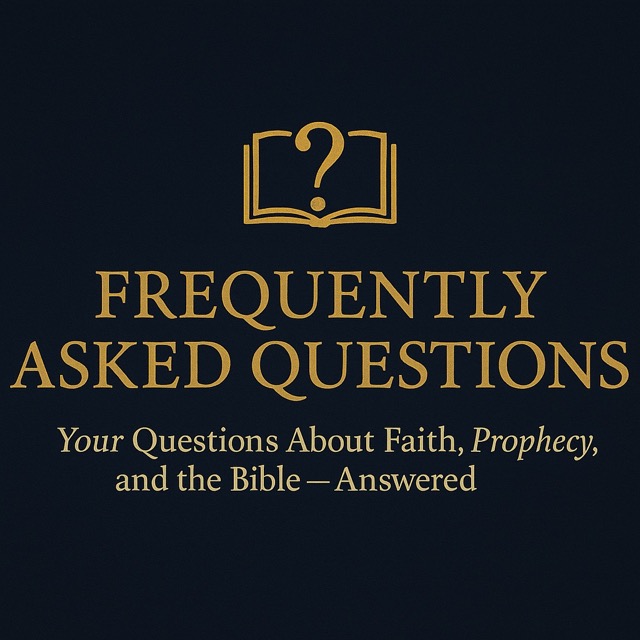
❓ Common Questions About Jesus’ Crucifixion Prophecies
🔹 Why did Jesus have to suffer so violently?
Old Testament scriptures like Isaiah 53, Psalm 22, and Zechariah 12 contain vivid Jesus’ crucifixion prophecies. They describe a Messiah who would suffer on our behalf. His pain wasn’t random — it fulfilled a divinely orchestrated substitution for our sin.
“He was pierced for our transgressions… and by His wounds we are healed.” — Isaiah 53:5
🔹 Which Old Testament prophecies predicted Jesus’ crucifixion?
Several prophetic passages point directly to Jesus’ death on the cross:
- Psalm 22:16 — “They pierced My hands and feet”
- Psalm 22:18 — “They cast lots for My clothing”
- Zechariah 12:10 — “They will look on Me whom they have pierced”
- Isaiah 53 — The Servant suffers silently, bears guilt, and is crushed for our sins
These Jesus’ crucifixion prophecies are fulfilled explicitly in the Gospels, especially in Matthew 27 and John 19.
🔹 Did people in Jesus’ day expect a suffering Messiah?
Most expected a military leader — a conquering king. But some Jewish traditions did anticipate suffering. Isaiah 53and Psalm 22 spoke of a Messiah who would be despised, pierced, and crushed.
Ancient rabbis even proposed two Messiahs:
- Messiah ben Joseph — the suffering servant
- Messiah ben David — the ruling king
Christians believe both are fulfilled in one Messiah — Jesus. He suffered during His first coming and will reign in His second.
🔹 How do we know Jesus fulfilled these prophecies?
Jesus fulfilled dozens of specific prophecies — including:
- Pierced hands and feet
- Silence before His accusers
- Mockery using prophetic words
- Burial in a rich man’s tomb
Even the prophetic timeline in Daniel 9:26 fits. Combined with the resurrection, this confirms He is the Promised One foretold in the crucifixion prophecies.
🔹 What does “guilt offering” mean in Isaiah 53:10?
The Hebrew word is אָשָׁם (asham), a term used in Leviticus 5 for a required sacrifice when someone was guilty. It wasn’t symbolic — it was legal.
Jesus became that final guilt offering. He fulfilled Isaiah 53 by satisfying God’s justice and reconciling us to Himself.
🔹 Did Jesus willingly choose the suffering described in prophecy?
Yes — and He said so:
“No one takes [My life] from Me. I lay it down of My own accord.” — John 10:18
Jesus fulfilled the crucifixion prophecies not out of weakness, but out of love and obedience. He was both the Lamb led to slaughter and the Shepherd who laid down His life.
🔹 How does Jesus’ suffering reveal God’s love?
The cross wasn’t just about justice. It was a revelation of God’s heart.
“God demonstrates His own love for us in this:
while we were still sinners, Christ died for us.” — Romans 5:8
The suffering described in the Jesus crucifixion prophecies shows us the depth of divine mercy. Wrath was absorbed… and love was poured out.
🕯️ Jesus’ Crucifixion: Prophecy Fulfilled, Salvation Accomplished
Jesus’ crucifixion was not a tragic accident.
It was the foretold climax of God’s redemptive plan.
Long before Roman nails pierced His hands, Jesus’ crucifixion was prophesied in Scripture:
- A rejected cornerstone
- A silent, suffering Servant
- A pierced Messiah
- A Lamb led to slaughter
Every shadow, every psalm, and every line of Isaiah pointed forward — to Him.
“This was to fulfill the word that is written in their Law…” — John 15:25
When you read Psalm 22, Isaiah 53, or Zechariah 12, you’re not reading ancient poetry.
You’re reading God’s plan unfolding — step by step — in Jesus.
So when we look at the cross, we don’t see defeat.
We see prophecy fulfilled.
We see love proven.
We see the Son of God crucified for us.
✝️ “By His wounds… we are healed.” — Isaiah 53:5

